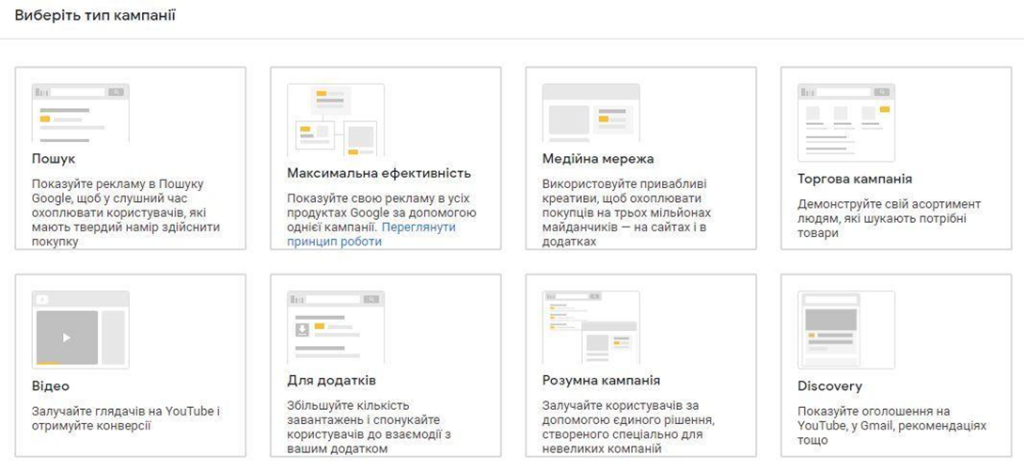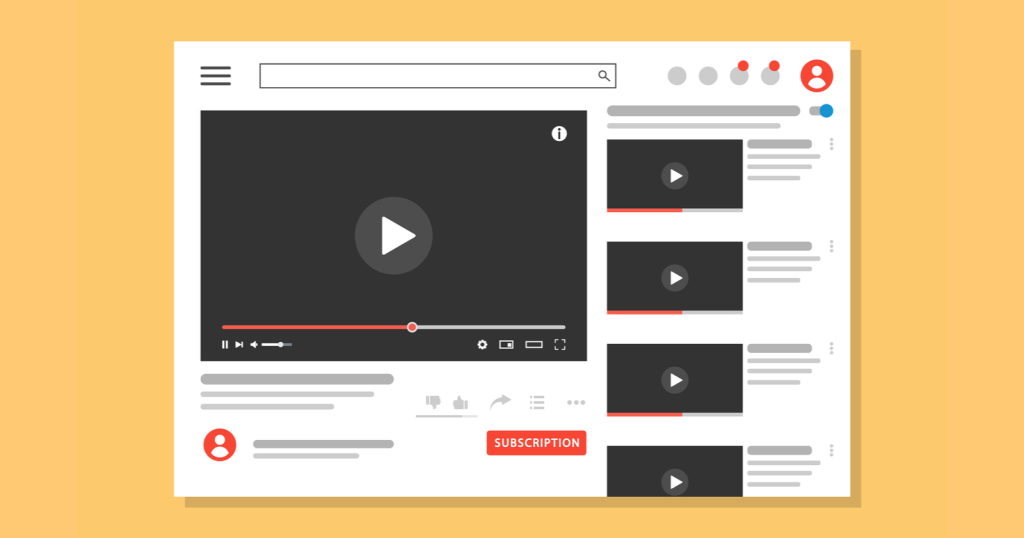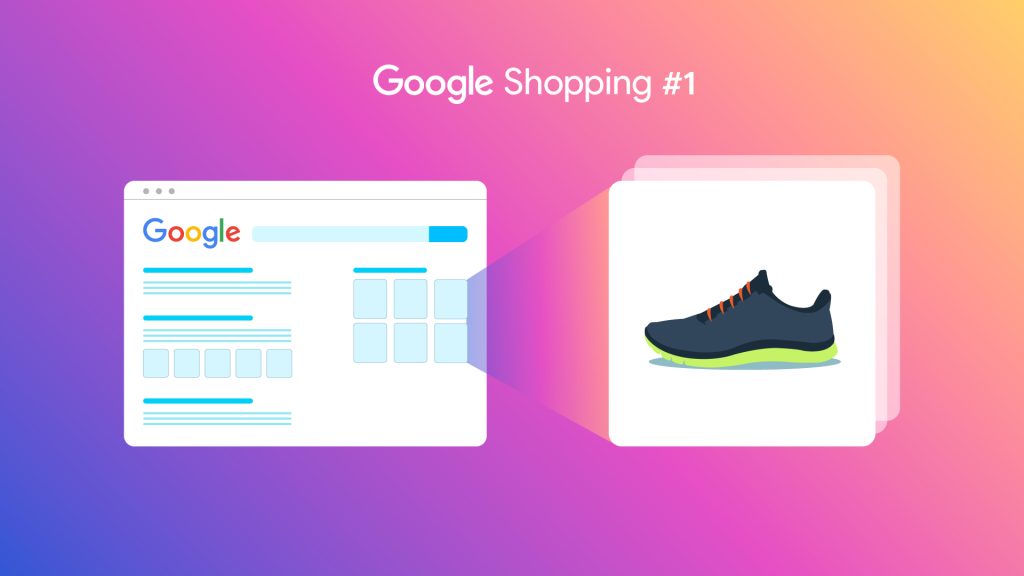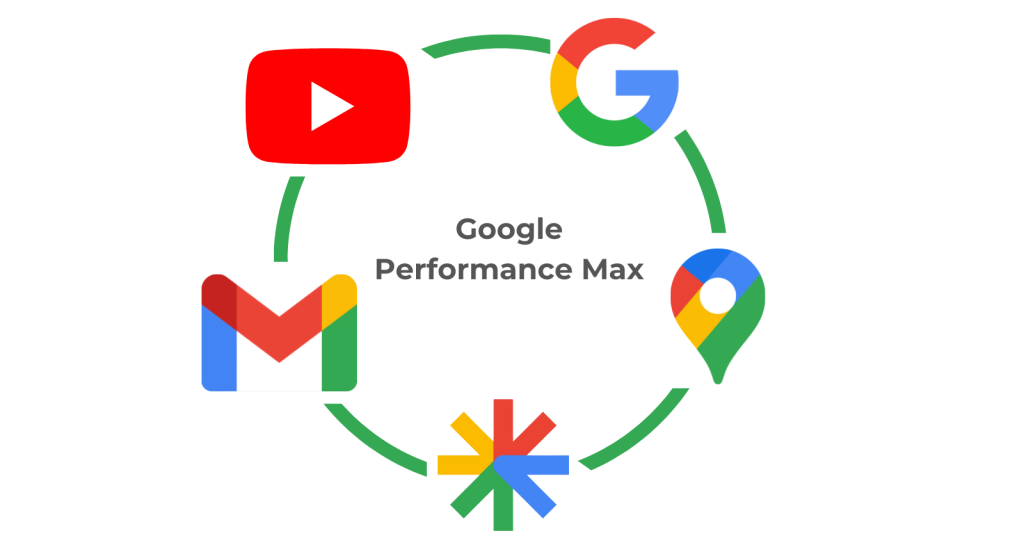Типы рекламных кампаний Google Ads
- 1 Отличие таргетированной рекламы от контекстной
- 2 Виды контекстной рекламы
- 2.1 Поисковая реклама (Search Ads) и поисковые партнерские сайты Google
- 2.2 Реклама в контекстно-медийной сети (КМС) или Google Display Network (Display Ads)
- 2.3 Реклама в YouTube (YouTube Ads)
- 2.4 Реклама в мобильных приложениях (Mobile App Ads)
- 2.5 Торговые рекламные кампании или Реклама Google Shopping
- 2.6 Реклама Discovery (Discover Ads)
- 2.7 Максимальная эффективность или Google Performance Max
- 2.8 Автоматизированная реклама или умные рекламные кампании (Smart Ads)
Отличие таргетированной рекламы от контекстной
Таргетированная реклама в социальных сетях и контекстная реклама в Google Ads имеют различия, которые определяются особенностями этих платформ и целями, которые перед ними ставят рекламодатели.
- Аудитория. В социальных сетях можно настроить более точную аудиторию, используя демографические данные, интересы, поведение пользователей и другие параметры. Google Ads же ориентируется на ключевые слова, которые пользователи вводят в поисковую строку, и на их интернет-поведение.
- Форматы рекламы. В социальных сетях доступны различные форматы рекламы, включая видео, изображения, карусели, сторис и другие. В Google Ads преобладают текстовые объявления, хотя также доступны и другие форматы, включая видео, изображения и шоппинг-объявления.
- Место показа. Таргетированная реклама в социальных сетях показывается прямо в ленте новостей пользователя или в сторис, в то время как контекстная реклама в Google Ads обычно отображается на страницах поисковой выдачи или на сайтах-партнерах Google.
- Взаимодействие с рекламой. В социальных сетях пользователи могут взаимодействовать с рекламой, оставлять комментарии, ставить лайки, делиться с друзьями. В Google Ads такой возможности нет.
- Цели рекламы. В обоих случаях можно настроить различные цели для рекламной кампании (увеличение трафика, продаж, заявок и т.д.), но в социальных сетях часто ставят цель увеличения узнаваемости бренда и вовлеченности аудитории, в то время как в Google Ads чаще нацелены на прямые продажи или переходы на сайт.
- Цена. Стоимость клика в Google Ads обычно выше, чем в социальных сетях, но это зависит от многих факторов, включая конкуренцию, выбранные ключевые слова и т.д.
- Спрос. Одно из ключевых отличий между таргетированной рекламой в социальных сетях и контекстной рекламой в Google Ads заключается в типе спроса, на который они ориентированы. Таргетированная реклама в социальных сетях обычно ориентирована на несформированный спрос. Это означает, что пользователи могут не искать активно продукт или услугу, но столкнувшись с рекламой, они могут проявить интерес. С другой стороны, контекстная реклама в Google Ads (особенно в поисковых кампаниях) ориентирована на сформированный спрос. То есть, пользователи уже активно ищут определенный продукт или услугу, и реклама предлагает им конкретное решение.
Важно отметить, что эти два типа рекламы могут дополнять друг друга и использоваться вместе для достижения максимального эффекта.
Виды контекстной рекламы
Поисковая реклама (Search Ads) и поисковые партнерские сайты Google
Поисковая реклама позволяет рекламодателям показывать свои объявления потенциальным клиентам в поиске. Когда пользователь вводит запрос, соответствующий ключевым словам заданным в рекламной кампании, объявление может быть показано вверху или внизу страницы результатов поиска. Рекламодатель платит за каждый клик по этому объявлению, то есть за каждый переход пользователя на его веб-сайт.
Поисковые партнерские сайты Google – это веб-ресурсы, которые сотрудничают с Google, чтобы показывать рекламу с помощью системы Google Ads на своих площадках. Эти партнерские сайты могут быть поисковыми движками, новостными порталами, а также другими онлайн-сервисами. Рекламодатели могут выбирать включение или исключение поисковых партнерских сайтов в своей кампании, чтобы контролировать, где именно будут показаны их рекламные объявления.
Преимущества:
- Точная таргетированность: реклама показывается тем пользователям, которые активно ищут конкретные товары или услуги, что повышает вероятность конверсии.
- Гибкость в управлении: можно быстро отрегулировать ставки на ключевые слова и контролировать бюджет кампании.
- Прозрачность результатов: предоставляются подробные отчеты о поисковых запросах, кликах, конверсиях и расходах, что помогает оптимизировать рекламные кампании.
Недостатки:
- Высокая конкуренция: стоимость кликов может быть высокой в популярных нишах из-за большого количества рекламодателей.
- Зависимость от запросов пользователей: если спрос на ключевые слова падает, эффективность рекламы может снижаться.
Реклама в контекстно-медийной сети (КМС) или Google Display Network (Display Ads)
Это графические и текстовые объявления на партнерских сайтах Google. Реклама в GDN может быть в различных форматах, включая статические и анимированные баннеры, изображения, а также текстовые объявления.
В КМС можно размещать рекламу в формате баннеров разных размеров, а также видеоролики на YouTube и партнерских платформах.
В GDN доступен широкий спектр таргетинговых опций. Рекламодатели могут выбирать аудиторию на основе интересов, поведения и характеристик пользователей, а также на основе контента страниц, на которых будет показана реклама. Такой подход позволяет точно таргетировать рекламу на конкретных пользователей и максимизировать ее эффективность.
Преимущества:
- Широкий охват аудитории. Контекстно-медийная сеть объединяет множество разнообразных веб-ресурсов, что позволяет достигать большой аудитории, увеличивая видимость рекламы.
- Разнообразные форматы объявлений. В данной сети доступны различные форматы рекламы – баннеры, текстовые объявления, ролики, интерактивные элементы, что позволяет адаптировать объявления под разные типы контента.
- Таргетинг. Возможность точного таргетинга позволяет рекламодателям выбирать целевую аудиторию на основе интересов, поведенческих данных, демографической информации и других критериев, что повышает эффективность кампании.
- Более доступные цены. Цены на рекламу в контекстно-медийной сети обычно ниже, чем на поисковой площадке.
Недостатки:
- Низкая конверсия. По сравнению с поисковой рекламой, конверсия объявлений в контекстно-медийной сети может быть ниже из-за более широкой аудитории и менее прямого запроса от пользователей.
- Нецелевой трафик. Из-за широкого охвата аудитории могут возникать проблемы с привлечением целевых клиентов, что может снизить эффективность рекламной кампании.
- Сложность контроля. Из-за большого количества партнерских ресурсов сложно полностью контролировать, где именно будут показаны объявления, что может вызвать нежелательный контекст или ассоциации.
- Трудности в измерении результатов. Измерение точных результатов и ROI (возврат на инвестиции) может быть сложнее из-за разнообразия форматов и каналов в сети.
Реклама в YouTube (YouTube Ads)
Рекламные ролики могут быть показаны перед началом просмотра (преролл), во время просмотра (например, серединные ролики) или после просмотра основного видео (постролл). Рекламодатели могут размещать объявления на каналах YouTube или на страницах с результатами поиска видеоконтента. Рекламодатели могут настраивать таргетинговые параметры, чтобы показывать рекламу только тем пользователям, которые соответствуют определенным интересам, запросам или демографическим характеристикам.
Преимущества:
- Огромная аудитория. YouTube имеет миллиарды активных пользователей, что предоставляет широкие возможности для привлечения новых клиентов.
- Видеоформат. Возможность использования видео рекламы позволяет более эмоционально и креативно подходить к рекламной кампании.
- Точная таргетированность. Реклама может быть нацелена на определенные интересы, поведение и демографические характеристики пользователей.
Недостатки:
- Пропуск рекламы. Пользователи могут пропустить рекламное сообщение после нескольких секунд просмотра.
- Зависимость от качества контента. Неудачный или раздражающий контент может оттолкнуть аудиторию.
Реклама в мобильных приложениях (Mobile App Ads)
Рекламодатели могут создавать кампании, чтобы привлечь больше пользователей к загрузке и установке их мобильных приложений из Google Play и App Store. Мобильные рекламные объявления часто включают кнопки “Установить” или “Скачать”, что делает процесс установки приложения быстрым и удобным. Рекламодатели могут настраивать таргетинг таким образом, чтобы показывать рекламу только на определенных типах мобильных устройств или тем пользователям, которые уже пользовались приложениями подобного типа или интересовались подобным контентом.
Преимущества:
- Высокая активность пользователей. Мобильные приложения обычно используются часто и длительно, что создает множество возможностей для показа рекламы и взаимодействия с аудиторией.
- Точный таргетинг. Рекламодатели могут использовать множество данных о пользователях, таких как поведенческие данные, местоположение, интересы и даже демографическая информация, для более точного определения целевой аудитории.
- Разнообразные форматы рекламы. В мобильных приложениях можно использовать разнообразные форматы рекламы, включая баннеры, видеоролики, интерактивные объявления и т.д., что позволяет создавать более привлекательные и эффективные объявления.
- Интеграция с контентом. Реклама может быть интегрирована в контент приложения, что может сделать ее более органичной и менее навязчивой для пользователей.
Недостатки:
- Возможные раздражения. Навязчивая реклама может вызвать негативные реакции у пользователей и даже привести к удалению приложения.
- Большое разнообразие устройств. В мире много различных мобильных устройств, и адаптация рекламы под все форматы может быть сложной задачей.
- Блокировщики рекламы. Некоторые пользователи устанавливают блокировщики рекламы, что может снизить охват вашей аудитории.
- Сложности в измерении результатов. Измерение точных результатов и эффективности рекламной кампании в мобильных приложениях может быть сложнее из-за разнообразия устройств и каналов.
Торговые рекламные кампании или Реклама Google Shopping
Этот вид объявлений включает фотографию продукта, его название, цену и название магазина. Такие объявления сразу привлекают внимание пользователей, позволяя им сразу оценить продукт и его стоимость.
Торговые объявления показываются на специальной вкладке Google Shopping на странице результатов поиска, что позволяет рекламодателям более эффективно продвигать свои товары среди заинтересованной аудитории.
Рекламодатели могут использовать ключевые слова и продуктовые атрибуты (например, бренд, цвет, размер) для таргетинга своих объявлений на более релевантные запросы пользователей.
Преимущества:
- Визуальная привлекательность. Реклама Google Shopping позволяет показывать изображения продуктов напрямую в результатах поиска, что сразу привлекает внимание пользователей и помогает им принимать решение о покупке на основе внешнего вида товара.
- Высокая конверсия. Так как пользователи видят изображение и цену товара уже на этапе поиска, они более информированы и готовы к покупке, что обычно приводит к более высокой конверсии по сравнению с другими форматами рекламы.
- Точный таргетинг. Рекламодатели могут настраивать рекламные кампании на конкретные продукты, категории товаров и даже определенные бренды, что позволяет достигать более релевантной аудитории.
- Сравнение товаров. Пользователи могут легко сравнивать цены и характеристики товаров прямо на странице результатов поиска, что способствует более информированным решениям о покупке.
Недостатки:
- Зависимость от визуальности. Если у товаров нет высококачественных и привлекательных изображений, эффективность рекламы может быть снижена.
- Конкуренция. В категориях с высокой конкуренцией может быть сложно выделиться, особенно если у вас нет уникальных преимуществ.
- Ограниченный контроль над текстом. В рекламах Google Shopping меньше возможностей для вставки дополнительной информации и текста, чем в некоторых других форматах.
- Сложность настройки и прохождение модерации в Google Merchant Center. Создание и настройка торговых рекламных кампаний может потребовать дополнительного времени и усилий для правильной организации товаров и данных.
Реклама Discovery (Discover Ads)
Рекламная кампания Discovery показывается в ленте с новостями и контентом, который интересен конкретному пользователю. Эта реклама отображается на главной странице устройств пользователей, что делает ее более заметной и вероятнее привлечет их внимание. Google использует данные о поведении и интересах пользователей, чтобы показывать рекламу, которая наиболее соответствует их предпочтениям.
Преимущества:
- Высокая релевантность. Реклама показывается в ленте контента, который пользователи уже исследовали или проявили интерес к нему, что делает объявления более релевантными и интересными.
- Большой охват аудитории. Платформы Google Discover и YouTube Home Feed имеют множество пользователей, что обеспечивает большой охват целевой аудитории.
- Разнообразные форматы объявлений. Реклама Discovery может использовать разнообразные форматы, такие как изображения, заголовки, описания и даже видеоролики, что позволяет создавать более привлекательные объявления.
- Высокий уровень таргетинга. Рекламодатели могут использовать различные параметры для таргетинга, включая интересы, демографические данные, поведенческие факторы и другие, что повышает эффективность кампаний.
Недостатки:
- Ограниченные настройки. Рекламодатели имеют ограниченные настройки в сравнении с некоторыми другими форматами рекламы, что может снизить уровень контроля.
- Соперничество за внимание. Поскольку объявления размещаются среди контента, конкуренция за внимание пользователей может быть высокой.
- Не всегда подходит для всех брендов. Реклама Discovery особенно хорошо работает для брендов, у которых есть визуально привлекательные продукты или контент. Для некоторых брендов это может быть менее подходящим форматом.
- Сложность измерения результатов. Как и с другими форматами контента, измерение точных результатов и анализ эффективности может быть сложнее из-за более органичного характера показа объявлений.
Максимальная эффективность или Google Performance Max
Google Performance Max – это тип рекламных кампаний, который использует машинное обучение и искусственный интеллект для максимизации эффективности рекламы. Он автоматически оптимизирует распределение бюджета между различными каналами Google, такими как поиск, мобильные приложения, YouTube, Google Discover и другие, чтобы достичь максимального количества конверсий или других целей кампании.
Преимущества:
- Автоматизация и оптимизация. Система использует машинное обучение и алгоритмы Google для автоматической оптимизации рекламной кампании на разных каналах, позволяя достигать максимальной производительности без необходимости ручных настроек.
- Максимальное охват аудитории. Автоматическая оптимизация позволяет показывать объявления на различных платформах Google, таких как поиск, YouTube, Google Discover и другие, максимизируя охват целевой аудитории.
- Упрощение процесса. Рекламодателям не нужно настраивать отдельные кампании для разных каналов и форматов, что экономит время и упрощает процесс управления.
- Динамическая оптимизация. Алгоритмы анализируют данные и реагируют на изменения в реальном времени, что позволяет адаптировать рекламные кампании под изменяющиеся условия и требования.
Недостатки:
- Ограниченный контроль. Рекламодатели могут иметь меньше контроля над конкретными настройками и стратегиями, чем при ручной настройке кампаний.
- Сложность измерения и анализа. В связи с автоматизацией и неявной оптимизацией может быть сложнее анализировать и понимать, какие именно факторы влияют на результаты кампании.
- Подходит не для всех бизнесов. В некоторых случаях бизнесам может потребоваться более точный контроль над кампаниями, особенно если они имеют специфические требования или ограничения.
- Риски из-за автоматизации. Несмотря на автоматическую оптимизацию, не всегда гарантируется, что кампания будет приносить максимальный результат, и могут возникать ситуации, которые требуют вмешательства рекламодателя.
Автоматизированная реклама или умные рекламные кампании (Smart Ads)
Система Google Ads автоматически оптимизирует объявления, чтобы максимизировать их производительность. Алгоритмы машинного обучения анализируют поведение пользователей и определяют наиболее эффективные стратегии для достижения целей кампании. Умные рекламные кампании предоставляют возможность рекламодателям получить хорошие результаты, даже если у них ограниченный опыт в рекламе.
Преимущества:
- Оптимизация результатов: система использует алгоритмы машинного обучения для настройки рекламных кампаний с учетом поведения пользователей.
- Экономия времени: автоматизация процесса настройки и оптимизации кампаний позволяет сосредотачиваться на других аспектах бизнеса.
- Точная таргетированность: реклама настраивается под интересы и характеристики конкретных пользователей.
Недостатки:
- Ограниченный контроль: некоторые аспекты рекламной кампании могут быть не доступны для ручной настройки.
- Зависимость от данных: эффективность умных кампаний зависит от качества и объема данных о пользователе.
Сравнение Google Performance Max и Умных рекламных кампаний (Smart Ads)
| Аспекты | Google Performance Max | Умные рекламные кампании (Smart Ads) |
| Управление и контроль | Максимальная автоматизация, рекламодатель управляет настройками | Автоматизация с учетом выбранных бизнес-целей |
| Форматы и площадки | Основной акцент на Google-платформах, множественные форматы | Разнообразные форматы и площадки внутри Google Ads |
| Охват аудитории | Максимизация охвата на разных платформах Google | Охват аудитории с учетом выбранных категорий и настроек |
| Цели и результаты | Максимизация общего результата через разные платформы | Автоматическая оптимизация с учетом выбранных бизнес-целей |
| Измерение и анализ | Относительно сложный анализ из-за широкой оптимизации | Относительно простой анализ с учетом выбранных бизнес-целей |
Таким образом, Google Ads предоставляет различные типы рекламных кампаний, каждый из которых имеет свои уникальные преимущества и возможности нацеливания. Выбор конкретного типа кампании зависит от целей рекламодателя и особенностей его бизнеса. Использование разнообразных форматов и каналов рекламы позволяет максимально эффективно продвигать продукты или услуги и привлекать целевую аудиторию.
Эксперт в области интернет-маркетинга. Руководитель маркетингового агентства MAVR.
Бизнес-степень «Мастер делового администрирования» (MBA).





